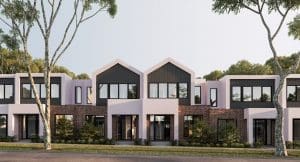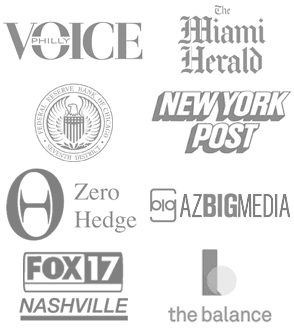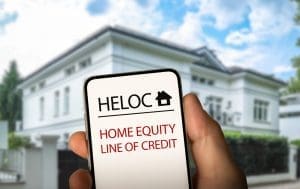Unlike getting a home equity line of credit on a primary residence , securing a HELOC on a investment property faces stricter requirements and higher rates (7.5–10% APR vs. 6.99–8.27%) due to increased lender risk, as real estate investors may prioritize primary home payments during financial distress.
Find Top Lenders that Offer HELOCs on Investment Property
In 2025, with U.S. median home prices at $412,000, real estate investors are leveraging the Home Equity Lines of Credit to tap into the equity of their rental or non-owner-occupied properties. This guide explores borrowing opportunities, cash-out alternatives and supported by four case studies, rental property financing options, and ranks the lenders offering HELOCs for investment properties. The RefiGuide will help you shop and compare bank and mortgage lenders offering home equity lines of credit on investment properties with competitive interest rates and reasonable closing costs.
Opportunities to Borrow Money with a HELOC on Investment Properties and Rental Homes
HELOCs on investment properties unlock capital for real estate investors without selling assets. Funds can finance down payments on new rentals, expanding portfolios.
For example, a $100,000 HELOC could cover a 20% down payment on a $500,000 property, generating rental income. Home equity loans are recommended for debt consolidation, paying off high-interest loans (e.g., 12% APR) to reduce costs.
HELOCs are highly regarded for emergency repairs, like HVAC replacements, can be funded quickly, maintaining tenant satisfaction.
Investment HELOC Lenders Require:
-
Equity: 20% minimum (e.g., $80,000 on a $400,000 property).
-
Credit Score: 680–700+, though some accept 620.
-
DTI Ratio: Below 43–50%, often offset by rental income (DSCR ≥1.0).
-
Rental Income: Proof of stable tenancy (e.g., two-year lease history). Benefits include lower rates than personal loans (12.65%) and flexibility to draw funds as needed, paying interest only on the amount used (e.g., $333/month for $50,000 at 8% APR). Fast funding (5–14 days) suits competitive markets, per NerdWallet.
Get Cash-Out with HELOCs on Investment Properties
A cash-out refinance, an alternative to a HELOC, replaces your existing mortgage with a larger one, providing a lump sum. For a $400,000 rental with a $200,000 mortgage, refinancing to $300,000 at 6.88% APR yields $100,000 cash, per Rocket Mortgage. This suits large purchases, like another property, but increases monthly payments and loan terms (15–30 years). HELOCs offer flexibility for ongoing expenses, while cash-out refinances provide one-time funds at potentially lower rates. Requirements include 20–25% equity, 620+ credit, and DTI below 50%. Cash-out funds can buy properties, fund renovations, or diversify investments, but higher payments and foreclosure risk require careful budgeting. Also consider a home equity loan on rental properties.
Top 2026 HELOCs for Investment Properties
-
Non-QM HELOC: Flexible for non-traditional borrowers, using bank statements or assets, rates 8–10% APR, ideal for self-employed investors.
-
DSCR HELOC: Qualifies based on rental income (DSCR ≥1.0), rates 6.375–8% APR, suits cash-flowing properties.
-
Traditional HELOC: Standard HELOC with stricter criteria (680+ credit), rates 7.5–10% APR, offered by banks.
-
Hard Money HELOC: Short-term, asset-based, rates 10–15% APR, fast funding for flips.
-
Private Home Equity Loan: Lump-sum homer equity loans from private lenders, rates 9–12% APR, customized terms.
-
Fix and Flip Loans: Short-term loans and home equity lines of credit for renovations, rates 8–15% APR, 70–90% ARV. Learn more about Non-QM loans online.
-
Cash-Out Refinancing: This is not a HELOC, but a popular alternative with larger mortgage for lump-sum cash, rates 6.88–7.26% APR, ideal for big investments.
Unique Opportunities with a HELOC for Home Remodeling and Rehabilitating Rental Properties
HELOCs are ideal for renovating investment properties, boosting value and rental income. A $50,000 HELOC at 8% APR can fund kitchen or bathroom upgrades, increasing a $350,000 property’s value by $50,000–$70,000 (14–20%), per Remodeling Magazine’s 2024 Cost vs. Value Report. Higher rents (e.g., $400/month increase) improve cash flow. Interest may be deductible as a business expense if used for improvements, per IRS, but consult a tax advisor. HELOCs’ quick funding (5–14 days) and interest-only payments during the draw period (e.g., $333/month for $50,000) make them cost-effective for phased renovations, unlike lump-sum loans. Projects like adding bedrooms or modernizing exteriors align with 2025’s demand for updated rentals.
Case Study 1: Expanding Real Estate Portfolio with HELOC
Background: Jane, a 35-year-old investor in Austin, Texas, owned a $400,000 rental with a $200,000 mortgage and $80,000 income.
Action: She secured a $100,000 HELOC, using $60,000 as a 20% down payment on a $300,000 rental property, financing the rest at 7% APR.
Outcome: The new property generated $2,500 monthly rent, covering its $1,800 mortgage and yielding $700 profit. With 3% annual appreciation, Jane’s net worth grew by $9,000 yearly, and the HELOC’s flexibility allowed future draws for repairs.
Case Study 2: Renovation Boost with HELOC on Rental Property
Background: John, a 40-year-old investor in Miami, Florida, owned a $350,000 rental with $150,000 equity and a 720 credit score.
Action: He obtained a $50,000 HELOC, funding kitchen and bathroom upgrades costing $40,000.
Outcome: The renovations increased the property’s value to $400,000 and rent by $400/month, yielding a 96% ROI. Interest-only payments ($267/month) and tax deductions saved $1,000 annually, enhancing cash flow.
Case Study 3: HELOC for Debt Consolidation
Background: Sarah, a 45-year-old investor in Denver, had $30,000 in 12% APR loans for her $500,000 rental property.
Action: She used a $50,000 HELOC with no closing costs to pay off the debt, drawing $30,000.
Outcome: Monthly payments dropped from $800 to $199 (interest-only), saving $7,212 annually. The HELOC’s remaining credit supported future maintenance, stabilizing her portfolio.
Case Study 4: Emergency Repairs and Rehab with HELOC
Background: Mike, a 50-year-old investor in Chicago, owned a $450,000 rental with $200,000 equity.
Action: He opened a $75,000 HELOC, drawing $20,000 for HVAC repairs.
Outcome: The repair preserved $2,800 monthly rent, with interest-only payments of $142/month. The HELOC’s availability ensured flexibility for future emergencies, maintaining tenant satisfaction and income.
5 Benefits of Getting a HELOC on a Rental Property
 Taking out a HELOC on a rental property can be a powerful financial tool for investors looking to expand their portfolio, improve cash flow, or create flexible access to capital.
Taking out a HELOC on a rental property can be a powerful financial tool for investors looking to expand their portfolio, improve cash flow, or create flexible access to capital.
This type of home equity line of credit enables you borrow against the equity in your investment property as needed, making it one of the most versatile financing options available.
Here are the five biggest benefits of getting a HELOC on a rental property in 2026.
1. Flexible Access to Capital for Upgrades and Repairs
Investment properties often require ongoing maintenance, renovations, or strategic upgrades to stay competitive. A HELOC gives you revolving access to funds you can draw from whenever needed, making it ideal for property improvements. Whether it’s updating a kitchen, repairing a roof, or renovating units between tenants, you only pay interest on what you use. This flexibility helps keep your property in top shape and supports long-term rental income growth.
2. Fueling Portfolio Expansion Without Selling Assets
One of the biggest advantages of a rental-property HELOC is the ability to access equity without selling the property and triggering taxes or losing long-term appreciation potential. Investors can use HELOC proceeds as down payments for new rentals, vacation rentals, or multifamily deals. This allows your existing assets to help fund new acquisitions, accelerating your path toward building a larger real estate portfolio. Many investors use HELOCs as a bridge to scale faster and secure deals more competitively.
3. Lower HELOC Interest Rates Compared to Other Types of Financing
HELOCs generally offer lower interest rates than credit cards, personal loans, or private-money financing. For investors who need short-term capital or want to cover gaps between buying and refinancing, a HELOC can provide affordable access to funds. Even with variable rates, the upfront cost is usually significantly lower than hard money, making HELOCs a cost-effective option for seasoned and first-time investors.
4. HELOC Interest-Only Payment Options Improve Cash Flow
Many investment-property HELOCs allow interest-only payments during the draw period, which can boost monthly cash flow. This is particularly valuable when you are renovating, onboarding new tenants, or repositioning a property. By keeping payments low during the initial stages, you can reinvest more money into improvements, stabilize the rental, and increase long-term profitability. Once the repayment phase begins, you can transition into fully amortizing payments when the property is generating stronger income.
5. Strong Tax Advantages for Many Investors
Certain HELOC expenses may be tax-deductible when funds are used for rental-property improvements or operational expenses. Investors may be able to deduct the interest as a business expense, lowering taxable income. Always consult a tax professional, but the potential write-offs often make HELOCs even more attractive compared to other forms of borrowing.
Top Ranked HELOC Lenders for Investment Properties
Below are the top 8 lenders advertising HELOCs for investment properties in 2026, with estimated APRs for a $50,000 line, 700+ credit, 80% LTV. Closing costs range from 0–5% ($0–$2,500). The RefiGuide will help you find out who offers HELOCs on investment property portfolios.
|
Lender |
APR |
Key Features |
|
|---|---|---|---|
|
New Silver |
6.375–7.50% | ||
|
Griffin Funding |
6.50–7.75% |
DSCR ≥0.75, 80% LTV, short-term rentals, 620+ credit |
|
|
West Capital Lending |
7.00–8.00% |
80% LTV, $100K–$3M, 7-day closings, portfolio HELOCs and equity loans |
|
|
Bank of America |
7.25–10.75% |
No closing costs, $5,000 minimum draw, fixed-rate locks |
|
|
U.S. Bank |
7.95–11.60% |
No closing costs, $5,000 lock, 47 states |
|
|
Flagstar Bank |
8.00–21.00% |
$75 annual fee, $5,000 minimum, nationwide |
|
|
LoanDepot |
7.75–18.00% | No closing cost options, fixed rate conversion locks | |
|
|
|||
|
Fifth Third Bank |
7.80–11.25% |
low closing costs, $95 fixed-rate fee, flexible draws |
|
|
|
|
Considerations for HELOCs and Investment Properties
Investment property HELOCs involve higher risks due to stricter criteria and rates. Defaulting risks foreclosure, impacting your portfolio. Variable rates may rise, increasing payments (e.g., from 7.5% to 10% APR). Limited lender availability requires diligent research. Ensure rental income (DSCR ≥1.0) and reserves (6–12 months) cover payments. Falling property values could reduce equity, complicating future borrowing. Compare rental property HELOC lenders using calculators, and consult advisors to mitigate risks.
HELOCs on investment properties offer investors a flexible, cost-effective way to access equity for portfolio growth, renovations, or debt management in 2025. With rates of 6.375–10% APR, they provide lower costs than personal loans (12.65%) but require careful planning due to foreclosure risks and stricter criteria (680+ credit, 20% equity). The case studies highlight practical applications, from buying properties to funding repairs. By comparing financing options like DSCR HELOCs, hard money home equity loans or cash-out refinances and selecting reputable HELOC lenders, investors can maximize returns. Always verify terms and consult professionals to align with your financial goals.
Frequently Asked Questions:
Can I use a HELOC for a down payment on an investment property?
Yes, you can use a HELOC from an existing property to fund the down payment on a new investment property. This strategy allows investors to leverage the equity in one property to finance another without selling or liquidating other assets. However, lenders may scrutinize the source of funds and ensure you can manage payments on both loans. It’s important to maintain a low debt-to-income ratio and have sufficient reserves, as using borrowed funds increases your overall financial obligation and risk exposure.
How much equity do you need to qualify for a home equity line of credit on an investment property?
You may be eligible for a home equity line of credit on an investment property, though it’s more challenging than on a primary residence. To qualify for a HELOC on an investment property, most lenders require at least 25% to 35% equity, meaning the loan-to-value (LTV) ratio must typically not exceed 65% to 75%. For example, if your rental property is worth $400,000, you’d likely need to owe no more than $280,000 to qualify for a HELOC. Because investment properties carry more risk than primary residences, lenders set stricter equity requirements to protect against potential default. A strong credit score and solid rental income history can also improve approval chances. Not all banks offer non-owner-occupied HELOCs, but the RefiGuide can help you shop around.
Can I get a HELOC on multifamily property?
Yes, some lenders offer HELOCs on multifamily properties, typically those with two to four units. Qualification depends on factors like credit score, loan-to-value ratio (usually up to 70–80%), and whether you occupy one of the units. Investment multifamily properties may face stricter requirements or higher rates. Portfolio and Non-QM lenders often provide more flexible HELOC options for investors seeking to access equity for renovations, expansion, or debt consolidation.
Can I get a HELOC on a condo?
Yes, many lenders allow HELOCs on condominiums, but eligibility depends on the condo’s approval status and the borrower’s financial profile. Lenders typically review the homeowners association (HOA) budget, insurance coverage, and owner-occupancy ratio. Conventional lenders often permit up to 80% loan-to-value (LTV) for qualified borrowers. For non-warrantable condos, borrowers may need to explore Non-QM or portfolio lenders that offer more flexible terms and higher tolerance for unique property types.

